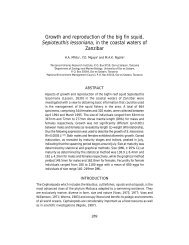gpa_east_africa_case.. - GRID Africa GeoPortal - UNEP
gpa_east_africa_case.. - GRID Africa GeoPortal - UNEP
gpa_east_africa_case.. - GRID Africa GeoPortal - UNEP
Create successful ePaper yourself
Turn your PDF publications into a flip-book with our unique Google optimized e-Paper software.
Vehicle Traffic. Smoke emitted from cars pollutes the air. A study conducted in 1996 byNEMC through the Commission for Energy, Environment, Science and Technology (CEEST),revealed high levels of SO 2 and Suspended Particulate Matters in some selected locationswithin Dar es Salaam. There is effective monitoring of air quality; industrial development,importation of vehicles, population growth and construction are likely to increase the problem.Oil spills. In DSM there is one oil refinery situated in Kigamboni near Dar es Salaam harbour.This plant receives 750,000 metric tons/ year of crude oil discharged from tankers intooffshore coupling pipeline located to the west of inner Makutumba island. Apart from wastesproduced in the refining process the refinery also pollutes the marine environment by sporadicoil spills which have resulted in chronic pollution of the harbour area and the coastline. Oilfrom tankers, waste oil discharged from garages, thermal power plants and few industries aredisposed without any treatment or control underground or into drains, rivers and creeks.There no statistical data as the pollution load due to oil spillage.Coastal erosion. The DSM beach stretches from Mpiji River to the north for about 100 kmand in the south to the Mzinga River and up to Mpakani village. The width of beaches variesfrom 0 in the creek areas, such as Gezaulole, Police Mess etc., to over 200m in other area,such as Mbweni, Ndege beach, Ununio, Kunduchi, Bunyuni and other areas. The northerncoast of DSM between Msasani bay and Mbweni is an area of sensitive sand beach ridges oftourist attraction. Erosion is common in areas under development pressure (tourist hotels,institutions, residential villas and fishing villages also caused by variation in the supply ofsediment load to the coastal system by rivers, quarrying of coraline limestone, sand andbeach rocks.Floods. A number of low-lying areas along the coast are currently subject to occasional orregular marine inundation at high tides. Soils characterised by mangrove swamps with poorlydrained clay exhibiting high shrink-swell properties. These areas are unsuited to urbandevelopment even if engineered barriers are constructed for shore protection. Highly mobileof sand dunes coupled with intense recreational use, under limited management, result inbeach erosion, which threatens property and physical structures. Sea level rise in large partsof the coastline to the north and south of the city is a potential environmental hazard. The Cityis dissected by a number of rivers close to sea level which are easily flooded during bothshort and long rains. The typical alluvial accumulation of silt and clay materials makes forpoor drainage posing the same development constraints as those found in coastal swamps.Fishing practices. Reefs break waves are breeding areas for most marine flora and fauna.Dynamiting smashes the coral reefs and destroys the habitat of fish and other reef dwellingorganisms. The rubble of smashed coral is subject to wave erosion and pollutes the marineenvironment. Application of dynamite for fishing cause considerable adverse effects to marineand coastal environment. Dynamite fishing cause explosion and fire and produce toxicsubstances in ocean and air. Exposure to these substances affects fishermen, damages fishand bottom flora and fauna. Apart from fire and explosion effects, dynamite fishing leads tooverfishing and destroys fish breeding grounds. The Aquamarine Profile of DSM regionproduced by NEMC 1995, indicates the main hot spots of dynamite fishing are Mwakatumbeislands, Msasani bay, Sinda islands, Kimbiji, Pemba mnazi, Kunduchi and Mbweni-Ununuovillages.Environmental ImpactsWater Resources. A water quality survey conducted in 1988 identified extensive surfacewater pollution as:• High conductivity suggested substantial dissolved and suspended solid loads.• Low dissolved oxygen indicated high biological and /or oxygen demands.• High bacteriological / pollution with evidence of pathogens with human excreta.• High kjeldahl nitrogen and low orthophosphate counts suggested extensiveeutrophication, as ammonia released from the decay of fresh sewage as well as allsoluble phosphates was being absorbed in the algae.Final Draft Report – Cost Benefit Case StudiesGPA Strategic Action Plan on Sewage, October, 200083



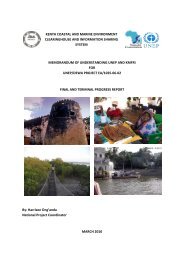
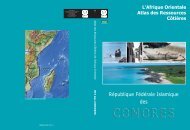
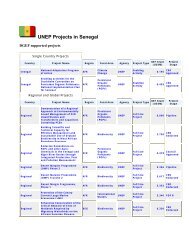


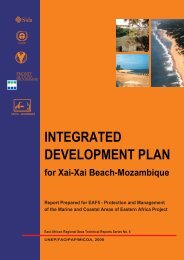

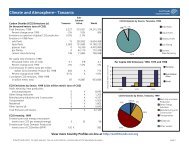

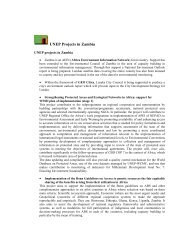
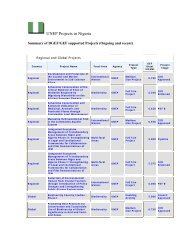
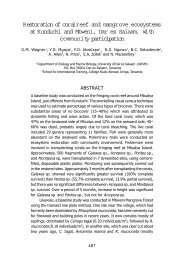
![Please Click to download [English] - GRID Africa GeoPortal - UNEP](https://img.yumpu.com/30633391/1/184x260/please-click-to-download-english-grid-africa-geoportal-unep.jpg?quality=85)
